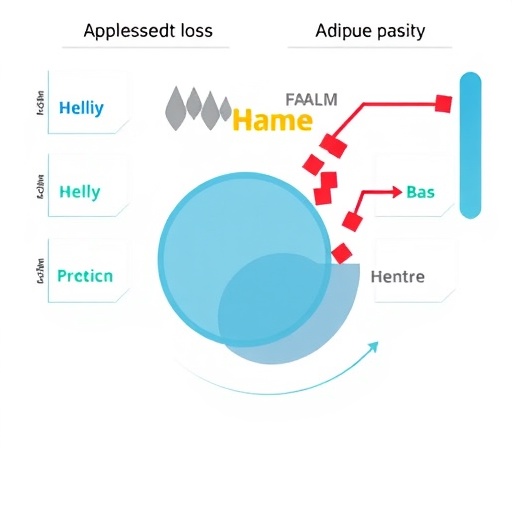
A groundbreaking investigation into the cellular dynamics of human adipose tissue reveals how obesity and subsequent weight loss orchestrate a selective remodeling of the adipose niche, shedding light on mechanisms that govern tissue homeostasis and regeneration. Adipocyte progenitor cells (APCs), pivotal players in maintaining the balance between mature adipocytes and the structural stroma, display remarkable heterogeneity. Distinct subsets of APCs have now been delineated, each characterized by unique gene expression signatures that dictate their roles in progenitor maintenance, differentiation, and fibrotic progression. These findings not only deepen our understanding of obesity-related adipose dysfunction but also highlight potential targets for therapeutic intervention.
The study mapped APC populations into several clusters: multipotent progenitors with high expression of DPP4 and low CD55, committed preadipocytes expressing canonical differentiation markers, regulatory cells governing adipogenesis, and profibrotic precursors marked by elevated ADAM12 and POSTN. Intriguingly, one committed preadipocyte subset exhibited a stressed transcriptomic profile reminiscent of mature adipocytes, including heightened levels of NOCT, a gene hypothesized to restrict preadipocyte commitment. Another subset selectively expressed genes associated with late-stage adipocyte maturation, denoting a complex and spatially localized landscape of differentiation within the adipose tissue microenvironment.
Such stressed and profibrotic subpopulations correlate strongly with adiposity and decrease significantly following weight loss, suggesting these cell states are dynamic and modifiable. Central to this modulation is the hypoxia-inducible factor 1A (HIF1A), which was upregulated in these APC subsets during obesity. HIF1A’s role in promoting fibrosis and suppressing adipogenesis, mediated through PPARG phosphorylation, underscores its contribution to the pathological remodeling of adipose tissue. Correspondingly, weight loss was shown to downregulate signatures of hypoxia, profibrotic TGFβ signaling, and anti-adipogenic WNT pathways, indicating a reversal of detrimental signaling that impairs progenitor differentiation.
.adsslot_w5SHov0zsf{width:728px !important;height:90px !important;}
@media(max-width:1199px){ .adsslot_w5SHov0zsf{width:468px !important;height:60px !important;}
}
@media(max-width:767px){ .adsslot_w5SHov0zsf{width:320px !important;height:50px !important;}
}
ADVERTISEMENT
Notably, beyond APCs, the vascular compartment within adipose tissue underwent similar shifts. Single-cell analyses delineated endothelial and mural cell subtypes, each bifurcating into basal and stressed states that reciprocally change with adiposity levels. Stressed endothelial cells overexpress genes such as APOLD1 and SNAI1, markers that hint at pathological neovascularization and an endothelial-to-mesenchymal transition, phenomena implicated in tissue fibrosis and vascular dysfunction. Concurrently, stressed mural cells elevated levels of ADAMTS1, a protein notorious for its anti-angiogenic properties and facilitation of pericyte detachment leading to capillary rarefaction.
The interplay between these stressed vascular cells and the adipose microenvironment highlights a complex network of maladaptive responses during obesity. However, weight loss appeared to markedly reduce both the abundance of these stressed vascular cell phenotypes and their associated gene expressions, implying that therapeutic intervention can restore vascular homeostasis. This recovery could be instrumental in reestablishing functional tissue perfusion and mitigating fibrotic remodeling, essential for healthy adipose tissue expansion or contraction.
A unifying feature of stressed cells across diverse lineages within adipose tissue was the activation of a common gene signature comprising 188 upregulated genes. This multicellular stress signature was detectable even in lean individuals, albeit at lower levels, and increased with aging and metabolic impairment. The facets of this gene expression profile encompassed responses to hypoxia, mechanical strain, oxidative stress, cytokine signaling via Gp130, DNA damage, and cell cycle arrest. These pathways collectively underscore the cellular machineries engaged under metabolic duress and highlight points where the tissue may attempt repair or succumb to injury.
Experimental induction of DNA damage in adipocyte progenitors using Etoposide recapitulated key in vivo stress responses, manifested by elevated stress marker proteins and a concomitant decline in differentiation capacity. These in vitro models emphasize the causal linkage between cellular stress signatures and functional impairment, offering a valuable platform to assess potential pharmacological strategies aimed at rescuing progenitor function.
Spatial transcriptomics further illuminated the architecture and zonation of stressed cell states within adipose tissues. Stress scores, calculated from upregulated stress genes, spatially localized to discrete niches, forming a specialized microenvironment where stressed cells accumulated and interacted. These niches demonstrated specific cellular compositions, integrating mature adipocytes, progenitors, endothelial cells, and mural pericytes, all contributing to a coordinated stress response. Such spatially resolved insights refine our understanding of how pathological signals propagate at the tissue level rather than solely within isolated cells.
Communication analyses leveraging ligand–receptor interaction models unveiled key signaling pathways operative within these stressed niches. Notable among these were THBS1 and ADGRE5, molecules integral to cell-cell communication that may perpetuate or resolve the stressed state through complex directional signaling networks. The balance and modulation of these pathways between obesity, lean, and weight-loss conditions shed light on the molecular dialogues underpinning tissue remodeling processes.
This comprehensive multimodal profiling of adipose tissue underscores the profound plasticity of its cellular constituents in response to metabolic states. The identification of specific stressed and profibrotic subpopulations, along with their molecular underpinnings and spatial distributions, provides an invaluable resource for unraveling the pathophysiology of obesity-related adipose dysfunction. Moreover, the demonstration that weight loss effectively attenuates these adverse phenotypes offers hope for reversing tissue damage and restoring healthy adipose function.
Such insights herald a new era of targeted interventions that could selectively modulate progenitor cell states and vascular health to stave off or ameliorate metabolic disease progression. By focusing on the cellular stress pathways and communication networks revealed here, future therapies may rejuvenate the adipose niche, enhance regenerative capacity, and ultimately improve systemic metabolic outcomes.
Further exploration into the mechanisms governing APC commitment and maturation—particularly in the context of the gatekeeping role of genes like NOCT—and the reversal of endothelial and mural cell stress will be vital. Understanding how these cellular stress responses can be therapeutically manipulated could unlock novel approaches to managing obesity and its associated comorbidities, representing a significant stride forward in metabolic health research.
Through this detailed dissection of the adipose microenvironment, the study bridges molecular, cellular, and spatial dimensions, providing a holistic view of tissue remodeling in obesity and post-weight loss states. It emphasizes the critical importance of multicellular coordination in maintaining tissue integrity and function, moving beyond single-cell analyses to appreciate the contextual interplay essential for regenerative medicine.
Subject of Research: Cellular and molecular remodeling of human adipose tissue in obesity and following weight loss.
Article Title: Selective remodelling of the adipose niche in obesity and weight loss.
Article References:
Miranda, A.M.A., McAllan, L., Mazzei, G. et al. Selective remodelling of the adipose niche in obesity and weight loss. Nature (2025). https://doi.org/10.1038/s41586-025-09233-2
Image Credits: AI Generated
Tags: adipocyte progenitor cell heterogeneityadipose tissue microenvironment dynamicscellular dynamics in human adipose tissuedifferentiation of adipocyte progenitor cellsfibrotic progression in obesitygene expression in adipose tissueimplications of adiposity on cell populationsmechanisms of weight loss and tissue homeostasisobesity-related adipose tissue remodelingregulation of adipogenesisstressed preadipocyte transcriptomic profilestherapeutic targets for obesity treatment





